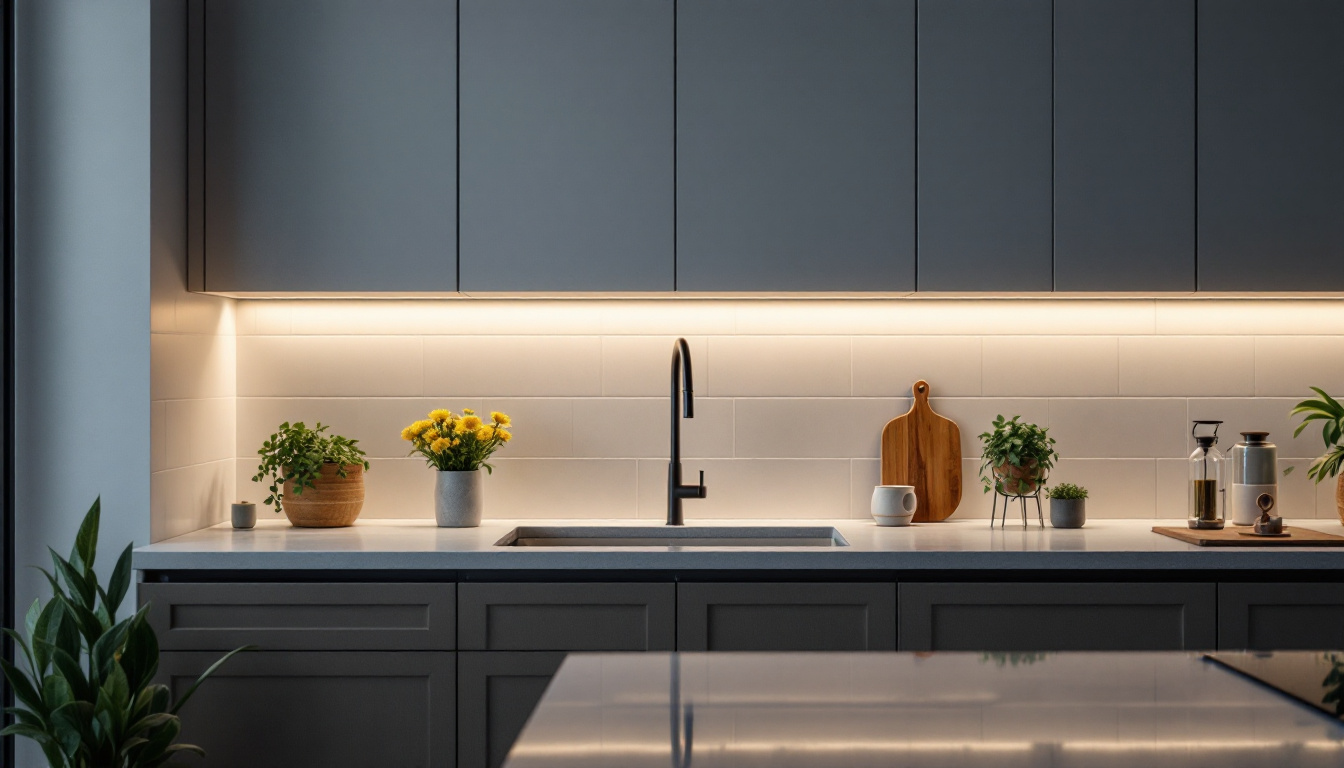
under counter lighting is an essential aspect of kitchen design that enhances both functionality and aesthetics. For lighting contractors, understanding the nuances of under counter lighting can lead to successful installations that meet client expectations while avoiding common pitfalls. This guide aims to provide insights into the best practices for under counter lighting in kitchens, ensuring that contractors can deliver optimal results.
Under counter lighting refers to fixtures installed beneath cabinets, typically above countertops. This type of lighting serves multiple purposes: it illuminates work areas, enhances the overall ambiance, and adds visual interest to the kitchen design. As a lighting contractor, grasping the fundamentals of under counter lighting can help in making informed choices about fixture selection, placement, and installation techniques.
There are several types of under counter lighting options available, each with its own unique characteristics and benefits. The most common types include LED strips, puck lights, and fluorescent fixtures. Understanding these types can aid in making the right choice for specific kitchen layouts and client preferences.
LED strips are popular due to their energy efficiency, long lifespan, and versatility. They can be easily cut to fit various lengths and come in a wide range of color temperatures, allowing for customization. Puck lights, on the other hand, provide focused lighting and are ideal for highlighting specific areas, such as a cutting board or a decorative backsplash. Fluorescent fixtures, while less common today, can still be found in some kitchens and offer a broad, even light distribution. Additionally, there are also smart lighting options available that can be controlled via smartphone apps or voice-activated devices, providing an extra layer of convenience and modernity to kitchen lighting solutions.
The benefits of under counter lighting extend beyond mere aesthetics. For contractors, emphasizing these advantages can help clients appreciate the value of a well-lit kitchen. First and foremost, under counter lighting improves visibility in work areas, making tasks such as food preparation and cooking safer and more efficient.
Moreover, under counter lighting can create a warm and inviting atmosphere, enhancing the overall kitchen experience. By using dimmable options, contractors can provide clients with the ability to adjust the lighting to suit different moods and occasions. This versatility is particularly appealing in open-concept spaces where the kitchen flows into living areas. Furthermore, under counter lighting can also serve as a design element that complements the kitchen’s color scheme and style. For instance, warm white lights can enhance the richness of wooden cabinetry, while cooler tones can accentuate modern, sleek designs. This thoughtful integration of lighting not only elevates the kitchen’s functionality but also contributes to a cohesive and stylish interior design, making it a focal point of the home.
Proper planning is crucial for a successful under counter lighting installation. This phase involves assessing the kitchen layout, determining the appropriate lighting type, and considering the electrical requirements. Each of these elements plays a significant role in ensuring that the final result meets both functional and aesthetic standards.
Before installation, it is essential to evaluate the kitchen’s layout thoroughly. This includes measuring the distance between cabinets and countertops, identifying the locations of appliances, and determining the overall style of the kitchen. A well-planned layout will help in deciding the number and type of fixtures needed, as well as their placement.
For instance, in a kitchen with an island, additional under counter lighting may be necessary to illuminate the work surface effectively. Similarly, if there are areas with darker finishes or limited natural light, contractors should consider using brighter fixtures or additional lighting sources to compensate.
As mentioned earlier, the choice of lighting type is critical. The decision should be based on the kitchen’s design, the tasks performed in the space, and the client’s preferences. Contractors should also consider the color temperature of the lights, as this can significantly impact the kitchen’s ambiance.
For example, warmer color temperatures (around 2700K to 3000K) create a cozy environment, while cooler temperatures (4000K to 5000K) offer a more modern and energetic feel. It is essential to discuss these options with clients to ensure their vision aligns with the final outcome.
Even experienced contractors can encounter pitfalls during under counter lighting installations. By being aware of these common mistakes, contractors can take proactive measures to avoid them, ensuring a smoother installation process and a satisfied client.
One of the most frequent issues in under counter lighting is inadequate illumination. Insufficient lighting can lead to shadows and dark spots, making it difficult for users to perform tasks effectively. Contractors should calculate the necessary lumens based on the kitchen’s size and layout, ensuring that the chosen fixtures provide adequate brightness.
It is also advisable to consider layering the lighting. Combining under counter lights with ambient and task lighting can create a balanced and well-lit environment. This approach not only enhances functionality but also contributes to the overall aesthetic appeal of the kitchen.
The placement of fixtures is another critical factor that can significantly impact the effectiveness of under counter lighting. Fixtures should be installed at the correct height and spacing to ensure even light distribution. Placing lights too far apart can create gaps in illumination, while fixtures installed too close together can lead to excessive brightness in certain areas.
Contractors should aim for a uniform distribution of light along the entire countertop surface. A general rule of thumb is to space fixtures approximately 24 to 30 inches apart, depending on the type of lighting used and the specific kitchen layout.
Electrical considerations are paramount in any lighting installation. Contractors must ensure that the electrical system can support the chosen fixtures, including accounting for wattage and circuit load. Neglecting these factors can lead to flickering lights, tripped breakers, or even fire hazards.
It is also essential to consider the placement of switches and dimmers. Installing switches in convenient locations can enhance usability, while dimmers provide flexibility in adjusting light levels. Contractors should discuss these options with clients to ensure a user-friendly experience.
Beyond functionality, under counter lighting can significantly enhance the aesthetic appeal of a kitchen. By selecting the right fixtures and incorporating design elements, contractors can create a visually stunning environment that reflects the client’s style.
Color and texture play a vital role in the overall design of a kitchen. When choosing under counter lighting, contractors should consider how the light interacts with various surfaces, such as countertops, backsplashes, and cabinetry. For instance, warm-toned lights can complement wooden cabinets, while cooler lights may enhance modern finishes like stainless steel or quartz.
Additionally, using fixtures with unique designs or finishes can add an artistic touch to the kitchen. For example, decorative pendant lights or stylish LED strips can serve as both functional and aesthetic elements, elevating the overall design.
Under counter lighting can also be used to create visual interest in the kitchen. By strategically placing lights to highlight specific features, such as decorative tiles or artwork, contractors can draw attention to these elements and enhance the overall ambiance.
Moreover, incorporating color-changing LED fixtures can allow clients to customize the lighting based on their mood or occasion. This flexibility not only adds a unique touch but also enhances the kitchen’s functionality for various activities, from cooking to entertaining.
Once the under counter lighting installation is complete, maintenance and upkeep are essential to ensure longevity and continued performance. Contractors should educate clients on proper care and maintenance practices to keep the lighting in optimal condition.
Dust and grime can accumulate on light fixtures over time, diminishing their brightness and effectiveness. Contractors should recommend regular cleaning schedules to clients, emphasizing the importance of using appropriate cleaning products that do not damage the fixtures.
For LED strips, a gentle wipe with a damp cloth is usually sufficient, while puck lights may require more thorough cleaning depending on their design. Educating clients on the best practices for maintaining their lighting can lead to increased satisfaction and longevity of the installation.
Encouraging clients to monitor their under counter lighting for any issues is also crucial. Flickering lights, unusual sounds, or changes in brightness can indicate underlying electrical problems that may need immediate attention. Contractors should provide clients with guidance on how to identify these issues and when to seek professional help.
By fostering a proactive approach to maintenance, contractors can help clients enjoy their under counter lighting for years to come, ensuring that the initial investment continues to pay off.
Under counter lighting is a vital component of kitchen design that enhances both functionality and aesthetics. For lighting contractors, understanding the various aspects of under counter lighting—from types and benefits to planning and installation—is essential for delivering successful projects. By avoiding common pitfalls and focusing on both practical and aesthetic considerations, contractors can create well-lit, inviting kitchen spaces that meet and exceed client expectations.
Ultimately, the goal is to provide clients with a kitchen that not only looks beautiful but also functions efficiently. By following the guidelines outlined in this article, lighting contractors can navigate the complexities of under counter lighting with confidence, ensuring a successful installation every time.
Ready to elevate your kitchen under counter lighting projects with the highest quality fixtures at the best value? Look no further than LumenWholesale. Our spec-grade lighting products are designed to meet the needs of the most discerning contractors, offering reliability and performance without the premium price tag. Say goodbye to local distributor markups and hello to our extensive selection, free shipping, and wholesale prices that put you in control of your budget. Make your next project shine by choosing Wholesale Lighting at the Best Value with LumenWholesale — where quality meets affordability and convenience.

Discover the essential steps to effectively train your team in mastering the use of 4 tube fluorescent fixtures.

Discover essential insights and expert advice on LED linear lights with our quick tips tailored for lighting contractors.

Discover essential resources and expert tips for lighting contractors to master the use of fluorescent tube lights.

Discover the essentials of grid lighting in just five minutes with this concise guide tailored for lighting contractors.